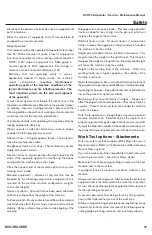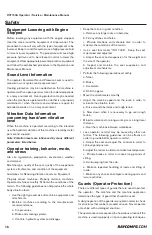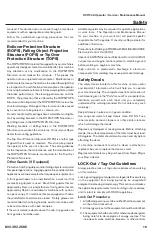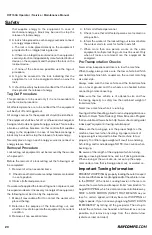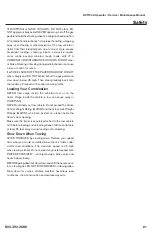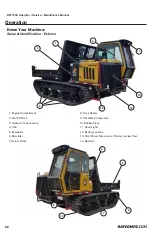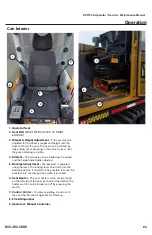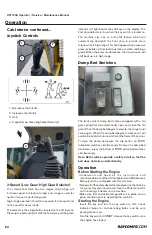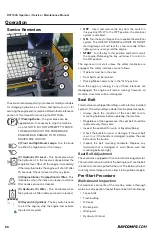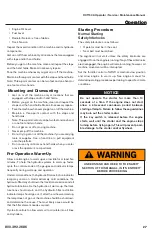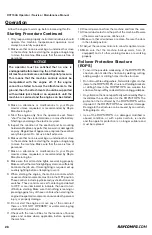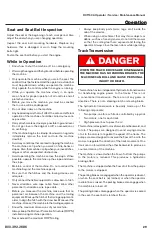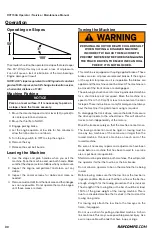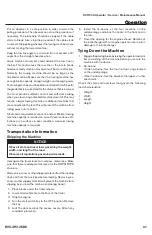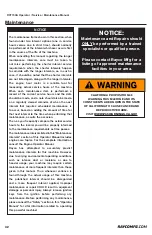
RCT150A Operator • Service • Maintenance Manual
800.392.2686
17
Safety
Disconnect the operator restraint devices (if equipped) and
exit the machine.
Block the wheels (if equipped), and set manual brake (if
equipped) to prevent movement.
Slope Operation
The crawler should not be operated on slopes that are steeper
than 30°. While this may not cause a loss of oil pressure,
loss of traction could occur thus creating a rollover condition.
NOTE: A 30° slope is equivalent to a 58% grade. A
constant grade of 58% represents a 58’ change in
elevation across a horizontal distance of 100’.
Machines that are operating safely in various
applications depend on these criteria: the machine
model, configuration,
machine maintenance,
operating speed of the machine, conditions of the
terrain, fluid levels, and tire inflation pressures. The
most important criteria are the skill and judgment
of the operation.
A well trained operator that follows the instructions in the
Operation and Maintenance Manual has the greatest impact
on stability. Operator training provides a person with the
following abilities: observation of working and environmental
conditions, feel for the machine, identification
of potential hazards, and operating the machine safely by
making appropriate decisions.
When you work on side hills and when you work on slopes,
consider the following important points:
Speed of travel – At higher speeds, forces of inertia tend to
make the machine less stable.
Roughness of terrain or surface – The machine may be less
stable with uneven terrain.
Direction of travel – Avoid operation the machine across the
slope. When possible, operate the machine up the slopes
and operate the machine down the slopes.
Place the heaviest end of the machine uphill when you are
working on an incline.
Mounted equipment – Balance of the machine may be
impeded by the following components: equipment that is
mounted on the machine, machine configuration, weights,
and counterweights.
Nature of surface – Ground that has been newly filled with
earth may collapse from the weight of the machine.
Surface material – Rocks and moisture of the surface material
may drastically affect the machine’s traction and machine’s
stability. Rocky surfaces may promote side slipping of the
machine.
Slippage due to excessive loads – This may cause downhill
tracks or downhill tires to dig into the ground, which will
increase the angle of the machine.
Width of tracks or tires – Narrower tracks or narrower tires
further increase the digging into the ground which causes
the machine to be less stable.
Implements attached to the machine hitch or drawbar – This
may decrease the weight on the uphill tracks. This may also
decrease the weight on the uphill tires. The decreased weight
will cause the machine to be less stable.
Height of the working load of the machine – When the
working loads are in higher positions, the stability of the
machine is reduced.
Operated equipment – Be aware of performance features of
the equipment in operation and the effects on machine stability.
Operating techniques – Keep all attachments or pulled loads
low to the ground for optimum stability.
Machine systems have limitations on slopes – Slopes can
affect the proper function and operation of the various machine
systems. These machine systems are needed for machine
control on slopes.
Note: Safe operation on steep slopes may require special
machine maintenance. Excellent skill of the operator and
proper equipment for specific applications are also required.
Consult the Operation and Maintenance Manual sections for
the proper fluid level requirements and intended machine use.
Work Tool options - Attachments
Only use work tools that are approved by Rayco for use on
Rayco machines. Refer to the Operation and Maintenance
Manual, Rayco options”.
If you are in doubt about the compatibility of a particular work
tool with your machine, consult your Rayco dealer.
Make sure that all necessary guarding is in place on the host
machine and on the work tool.
If equipped, keep all windows and doors closed on the
machine.
Always wear protective glasses. Always wear the protective
equipment that is recommended in the work tool’s operation
manual. Wear any other protective equipment that is required
for the operating environment.
To prevent personnel from being struck by flying objects,
ensure that all personnel are out of the work area.
While you are performing any maintenance, any testing, or any
adjustments to the machine, stay clear of the following areas:
cutting edges, pinching surfaces, and crushing surfaces.
Summary of Contents for RCT150A 2019
Page 48: ...RCT150A Operator Service Maintenance Manual 48 Hydraulic Schematic 806401 Rev A 210 bar ...
Page 49: ...RCT150A Operator Service Maintenance Manual 800 392 2686 49 Hydraulic Schematic 806401 Rev A ...
Page 50: ...RCT150A Operator Service Maintenance Manual 50 Hydraulic Schematic 806401 Rev A ...
Page 52: ...RCT150A Operator Service Maintenance Manual 52 Hydraulic Schematic 806401 Rev A ...
Page 53: ...RCT150A Operator Service Maintenance Manual 800 392 2686 53 Hydraulic Schematic 806401 Rev A ...
Page 62: ...RCT150A Operator Service Maintenance Manual 62 Troubleshoot ...
Page 63: ...RCT150A Operator Service Maintenance Manual 800 392 2686 63 Troubleshoot ...
Page 64: ...RCT150A Operator Service Maintenance Manual 64 Troubleshoot ...
Page 65: ...RCT150A Operator Service Maintenance Manual 800 392 2686 65 Troubleshoot ...
Page 66: ...RCT150A Operator Service Maintenance Manual 66 Troubleshoot ...
Page 67: ...RCT150A Operator Service Maintenance Manual 800 392 2686 67 Troubleshoot ...
Page 68: ...RCT150A Operator Service Maintenance Manual 68 Troubleshoot ...
Page 69: ...RCT150A Operator Service Maintenance Manual 800 392 2686 69 Troubleshoot ...
Page 70: ...RCT150A Operator Service Maintenance Manual 70 Troubleshoot ...
Page 71: ...RCT150A Operator Service Maintenance Manual 800 392 2686 71 Troubleshoot ...
Page 72: ...RCT150A Operator Service Maintenance Manual 72 Troubleshoot ...
Page 73: ...RCT150A Operator Service Maintenance Manual 800 392 2686 73 Troubleshoot ...















